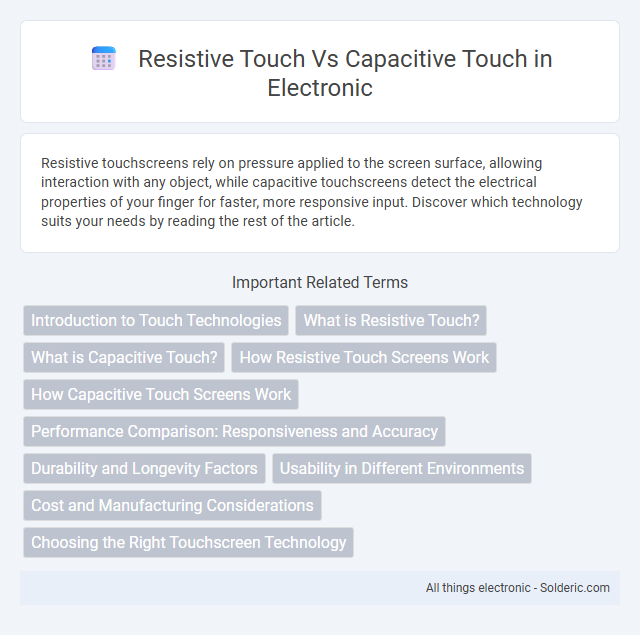Resistive touchscreens rely on pressure applied to the screen surface, allowing interaction with any object, while capacitive touchscreens detect the electrical properties of your finger for faster, more responsive input. Discover which technology suits your needs by reading the rest of the article.
Comparison Table
| Feature | Resistive Touch | Capacitive Touch |
|---|---|---|
| Technology | Pressure-based, multiple layers detect touch via resistive pressure | Detects touch through electrical conductivity of the skin |
| Durability | Less durable, susceptible to scratches and wear | More durable and resistant to scratches |
| Touch Sensitivity | Works with finger, stylus, gloved hand | Requires conductive touch, usually finger or special stylus |
| Multi-touch Support | Limited or no multi-touch | Supports multi-touch gestures |
| Image Clarity | Lower image clarity due to additional layers | Higher image clarity and brightness |
| Cost | Lower cost | Higher cost |
| Common Usage | Industrial, budget devices, stylus input | Smartphones, tablets, modern touchscreens |
Introduction to Touch Technologies
Resistive touch technology relies on pressure applied to two conductive layers, enabling input through a stylus or finger and offering compatibility with various touch objects. Capacitive touch technology detects changes in electrical charge on a glass panel, providing high sensitivity, multi-touch support, and enhanced durability for modern devices. Both technologies serve different use cases, with resistive touch preferred for rugged environments and capacitive touch dominating consumer electronics.
What is Resistive Touch?
Resistive touch technology detects input through pressure applied on two flexible layers that are separated by a small gap, allowing accurate touch detection with a finger, stylus, or any object. This touchscreen type consists of a resistive layer and a conductive layer that register a touch when the layers make contact, commonly found in older smartphones, industrial devices, and ATM machines. Resistive touchscreens offer high durability and work effectively in environments with water, dust, or gloves, making them suitable for rugged applications.
What is Capacitive Touch?
Capacitive touch technology relies on the electrical properties of the human body to detect touch input, using a layer of capacitive material that stores electrical charge. When a finger touches the screen, it distorts the screen's electrostatic field, allowing the device to precisely register the location of the touch. This technology enables multi-touch functionality, higher sensitivity, and greater durability compared to resistive touch screens.
How Resistive Touch Screens Work
Resistive touch screens operate by detecting pressure applied to the screen surface, consisting of multiple layers including two flexible sheets coated with a resistive material separated by an air gap. When a user presses down, the top layer makes contact with the bottom layer, causing a change in electrical resistance that is measured to pinpoint the exact location of the touch. This technology supports precise input with any type of stylus or finger and remains functional even when exposed to water or dust.
How Capacitive Touch Screens Work
Capacitive touch screens function by detecting the electrical properties of your skin through a layer of capacitive sensors that form an electrostatic field. When your finger touches the screen, it distorts the field, altering the capacitance at that point, which the device processes to determine touch location. This technology enables multi-touch capabilities and faster, more precise input compared to resistive touch screens that rely on pressure.
Performance Comparison: Responsiveness and Accuracy
Capacitive touchscreens offer superior responsiveness and higher accuracy due to their reliance on the electrical properties of the human body, allowing for precise multi-touch gestures and faster input recognition. Resistive touchscreens, which operate through pressure applied to flexible layers, tend to exhibit slower response times and lower accuracy, especially with light or fast touches. This performance difference makes capacitive technology more suitable for modern smartphones and tablets requiring rapid and precise user interaction.
Durability and Longevity Factors
Resistive touchscreens feature multiple layers that physically respond to pressure, making them more prone to wear and tear over time due to constant contact and potential layer damage. Capacitive touchscreens rely on the electrical properties of the human body, resulting in greater durability with less mechanical strain and improved longevity in high-use environments. The use of harder glass surfaces in capacitive displays further enhances resistance to scratches and impacts compared to the flexible plastic layers found in resistive screens.
Usability in Different Environments
Resistive touchscreens excel in environments where users wear gloves or use styluses, as they detect pressure regardless of conductivity, making them ideal for industrial or medical settings. Capacitive touchscreens offer superior responsiveness and multi-touch capabilities but may struggle with accuracy when gloves are worn or in wet conditions. Your choice depends on the environment's demands, balancing precision and durability for optimal usability.
Cost and Manufacturing Considerations
Resistive touchscreens generally have lower production costs due to their simpler design, involving multiple flexible layers and pressure-sensitive components, making them economical for budget devices and industrial applications. Capacitive touchscreens require more sophisticated materials like indium tin oxide (ITO) and precise manufacturing processes, increasing their cost but enabling higher sensitivity and multi-touch capability. Manufacturing complexity for capacitive screens also involves stringent cleanroom conditions and advanced circuitry integration, contributing to higher investment and maintenance expenses.
Choosing the Right Touchscreen Technology
Resistive touchscreens offer accurate input with any object, making them ideal for environments requiring glove use or stylus interaction, while capacitive touchscreens provide superior sensitivity and multi-touch capabilities favored in consumer electronics. Factors such as durability, environmental conditions, and user interaction style determine the optimal touchscreen choice, with resistive displays excelling in rugged or industrial settings and capacitive screens dominating in modern smartphones and tablets. Selecting the right technology hinges on balancing precision, durability, and user experience tailored to specific application requirements.
resistive touch vs capacitive touch Infographic

 solderic.com
solderic.com